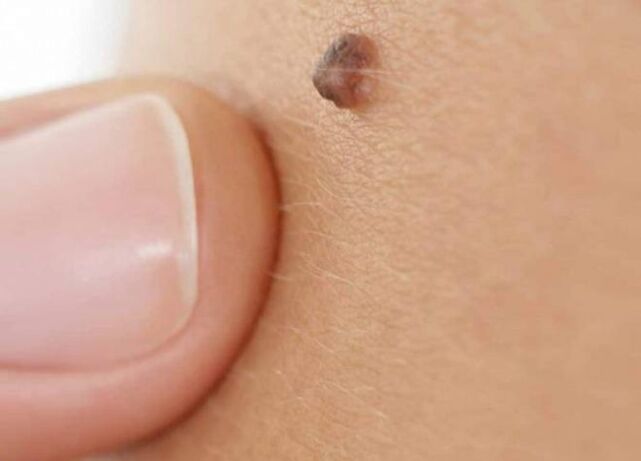Human papillomavirus is one of the most common and is found in the body of 90% of the world’s population. Most of its carriers are unaware of its presence and do not find any suspicious signs in them. That is why it has become widespread.
What is a papilloma?
Papilloma is a benign pathological formation of viral etiology. The appearance of papilloma is caused by the action of human papillomavirus (HPV). On the skin it usually manifests itself in the form of cosmetic defects - warts and genital warts, in the larynx it can cause respiratory failure, and on the mucous membranes of internal organs to bleeding and ulcers. There are 27 types of HPV - some of which are safe for health, others can develop into malignant tumors and lead to cancer.
When identifying, special attention should be given to women, as they are at high risk for developing cervix. Pregnant women during pregnancy are at risk of infection in children.
HPV is characterized by a latent (latent) course and while a person has strong immunity, the virus does not manifest itself in any way whatsoever (the incubation period lasts from 2 weeks to several years). Under the influence of several factors, the virus is activated, reproduces and manifests itself clinically.

Causes of infection with papilloma virus
How HPV is infected:
- unprotected sex
- in contact with the skin and mucous membranes of an infected person
- the use of the wearer's personal belongings
- when visiting public places with high humidity and high crowds (swimming pools, saunas, beaches)
The most common is the sexual route of infection with the virus, a household route is rarely recorded, because the virus stays in the environment for a short time.
Virus activation is facilitated by:
- weakened immunity
- contagious disease
- interfere with the gastrointestinal tract
- exacerbation of chronic disease
- pregnancy
- long -term use of some medications (antibiotics, anticoagulants, etc. )
- smoking, alcohol abuse
- severe stress
HPV penetration is facilitated by microtrauma, cracking, abrasions and other damage to the skin.
Symptoms of papilloma
Symptoms depend on the location of the formation and the type of HPV. The first "bells" about the presence of the virus are external manifestations in the form of genital warts (usually appearing in intimate places) and warts (often formed on the face, neck, limbs).
Less commonly, papillomas are accompanied by symptoms such as:
- peeling, itching, redness (skin)
- discomfort while walking (genitals)
- out of the nipple (breast canal)
- difficulty breathing (larynx)
- painful bowel movements (bowel)
Diagnosis of papilloma
Diagnosis is made by a venereologist, dermatologist, immunologist or gynecologist / urologist.
- Clinical examination - visual examination and conversation with the patient.
- Laboratory and instrumental analyzes were prescribed to obtain a complete picture of the disease:
- general and biochemical blood tests
- PCR (Polymerase chain reaction) test - determines the type of virus and its amount in the body.
If the only method of treatment is papilloma removal, then material biopsies are performed in parallel to conduct cytological studies and determine oncological risk.
Methods of treatment
There are no drugs and methods that can completely eliminate HPV from the human body. The effect is only made on the consequences of the virus. General antiviral therapy is performed in cases of highly oncogenic virus types that are localized in the area of the anogenetic tract. Patients with previously diagnosed papillomas are advised to check systematically and use barrier contraceptives so as not to infect the partner with the virus.
It is recommended to remove the papilloma, because the virus in the epithelial cells causes it to multiply, new papillomas form or existing ones grow back.
Depending on the location and symptoms of the papilloma, they use the following removal methods:
- Laser surgery - papillomas are treated with surgical laser beams. This method does not require hospitalization and the damaged area heals quickly. Lasers are applied to the face and visible parts of the body.
- Radiosurgery is contactless exposure to high -frequency radio waves, under the influence of which the neoplasm is removed. This method is recognized as effective, but expensive.
- Cryodestruction - coagulation of neoplasms with liquid nitrogen. Scars may remain at the site of exposure.
- Chemical destruction - cauterization with chemical acids. The procedure is quite sensitive and there is a high risk of touching adjacent tissues and getting chemical burns.
- Surgical removal - rarely used, in case of suspected malignant processes.
- Folk remedies-moxibustion of foci with folk remedies (garlic, celandine, lemon balm, cabbage leaves, castor oil etc. )
Currently, vaccines have been developed to prevent highly oncogenic types of viruses (species 16 and 18), which are used in many countries.
For disease prevention, it is recommended to have protected sex, use personal hygiene items, strengthen the immune system and be regularly examined by immunologists and gynecologists. If you notice symptoms of HPV, it is recommended to see a doctor immediately.















































































